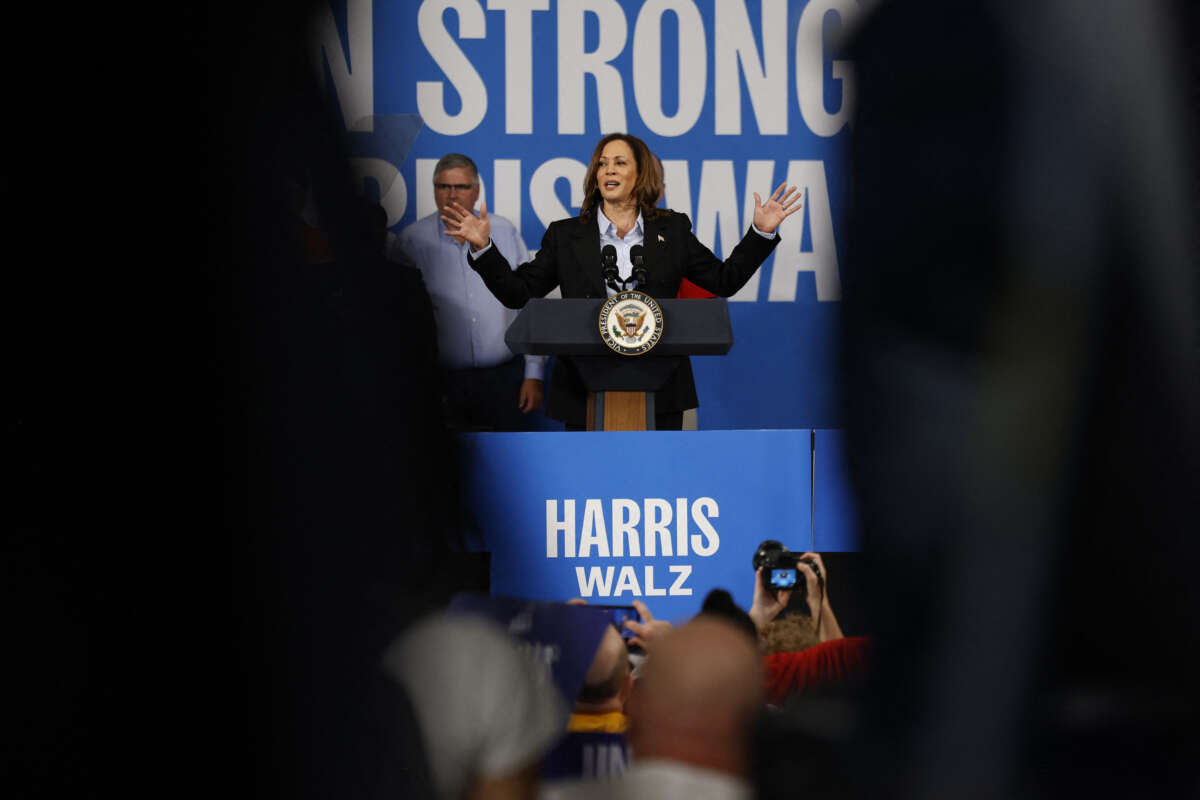Democratic candidate for president and current Vice President Kamala Harris is leading her Republican rival, former President Donald Trump, in most national polls as of late. But due to the Electoral College, the two are technically tied — and Trump could even be considered the frontrunner in the race, as the archaic mechanism for selecting presidents inherently favors Republicans.
The Harris campaign is playing itself up as the “clear underdog” in the race. This is likely an attempt to deter Democratic-leaning voters from becoming overconfident, which could result in lower voter turnout on Election Day in November.
Still, while an aggregate of polling data shows Harris ahead of Trump in the average national poll by about 3.1 percent as of Thursday morning, the two are neck-and-neck when it comes to the Electoral College, the constitutional mechanism used for selecting the president.
According to Electoral-Vote.com, Harris and Trump are statistically tied in at least eight states: Nevada, Arizona, Wisconsin, Michigan, Pennsylvania, Virginia, North Carolina and Georgia. (The website also notes that the two are statistically tied in Indiana, but that’s due to a lack of polling data, and other election prognosticators believe that Trump is a lock to win that state.)
Those eight states up for grabs represent 106 Electoral College votes. Meanwhile, Harris has 213 Electoral College votes from states that are likely to go her way, while Trump has 219 votes from states leaning toward him.
The closeness of the race, and the slight advantage for Trump, demonstrates a well-known phenomenon in the modern era of presidential politics: that the Republican candidate has an inherent edge in the Electoral College over the Democratic nominee, no matter who the choices for either party are. A large part of that is because of redistricting and the redistribution of congressional districts across the states every 10 years. The Electoral College system also gives states with smaller populations, which tend to be more Republican, a greater proportion of electors than larger, more Democratic-leaning states receive.
Indeed, over the past quarter-century, Democrats have won the popular vote in presidential elections in five of the last six races. However, the parties have split wins in the election due to the Electoral College, with both parties winning three races each, including in George W. Bush’s win in 2000 and Trump’s win in 2016, which were both popular vote losses.
Indeed, even though President Joe Biden defeated Trump by a popular vote margin of over 7 million votes, in just three states — Wisconsin, Michigan and Georgia — the margin of victory was just 186,649 votes. Had those votes gone for Trump instead (representing a flip of just 0.12 percent of the electorate), it would have changed the outcome, giving the Republican candidate a second term in the White House instead, in spite of the wide popular vote margin Biden had throughout the country.
According to an analysis from Cook Political Report’s Amy Walter in 2022, this year’s presidential race may be the most advantageous yet for a Republican nominee. “When looking exclusively at the Electoral College map, Republicans are enjoying a stronger advantage than at any point” in the past 25 years, Walter wrote, adding that the GOP candidate “taking just 48 percent of the two-party popular vote could still win a comfortable Electoral College majority.”
The Electoral College also results in most of the country being overlooked. “For the next 10 weeks, 7 states will receive all of the focus of the presidential campaigns,” Rep. Daniel Goldman (D-New York) posted on X late last month. “43 states will effectively be ignored. That’s not how the President of the US should be chosen.”
Those 43 states represent around 80 percent of the U.S. population, according to an analysis from National Popular Vote, an organization that advocates for ending the Electoral College in favor of a popular vote model to pick the president instead.
Speaking to Truthout about the possibility of the Electoral College choosing the candidate who did not win the popular vote, National Popular Vote Senior Consultant Patrick Rosenstiel said he couldn’t make a prediction on the issue, but that the “current system creates an unnecessary crisis in American politics.”
“The next presidential election will come down to razor thin margins in a handful of swing states. Swing state courts and hair splitting law suits are more likely to determine who the next president is than voters,” Rosenstiel warned.
Our most important fundraising appeal of the year
December is the most critical time of year for Truthout, because our nonprofit news is funded almost entirely by individual donations from readers like you. So before you navigate away, we ask that you take just a second to support Truthout with a tax-deductible donation.
This year is a little different. We are up against a far-reaching, wide-scale attack on press freedom coming from the Trump administration. 2025 was a year of frightening censorship, news industry corporate consolidation, and worsening financial conditions for progressive nonprofits across the board.
We can only resist Trump’s agenda by cultivating a strong base of support. The right-wing mediasphere is funded comfortably by billionaire owners and venture capitalist philanthropists. At Truthout, we have you.
We’ve set an ambitious target for our year-end campaign — a goal of $166,000 to keep up our fight against authoritarianism in 2026. Please take a meaningful action in this fight: make a one-time or monthly donation to Truthout before December 31. If you have the means, please dig deep.
